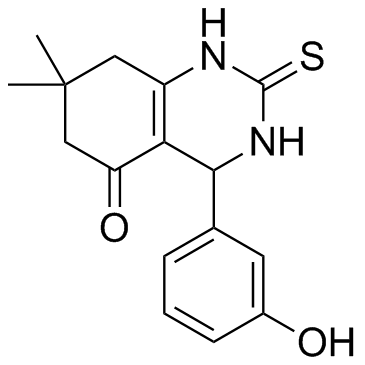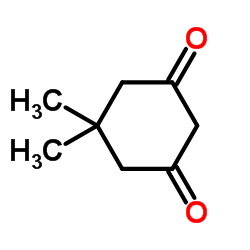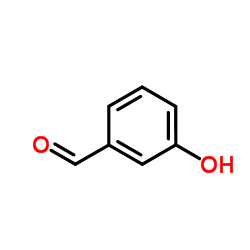863774-58-7
| Name | 4-(3-hydroxyphenyl)-7,7-dimethyl-2-sulfanylidene-3,4,6,8-tetrahydro-1H-quinazolin-5-one |
|---|---|
| Synonyms |
4-(3-Hydroxyphenyl)-7,7-dimethyl-2-thioxo-2,3,4,6,7,8-hexahydro-5(1H)-quinazolinone
Rac-Dimethylenastron Eg5 Inhibitor III DIMETHYLENASTRON 4-(3-hydroxyphenyl)-7,7-dimethyl-2-thioxo-2,3,4,6,7,8-hexahydroquinazolin-5(1H)-one 2,3,4,6,7,8-Hexahydro-4-(3-hydroxyphenyl)-7,7-dimethyl-2-thioxo-5(1H)-quinazolinone |
| Description | Dimethylenastron is a potent Eg5 inhibitor, with an IC50 of 200 nM. |
|---|---|
| Related Catalog | |
| Target |
Eg5:200 nM (IC50) |
| In Vitro | Dimethylenastron is a potent Eg5 inhibitor, with an IC50 of 200 nM. Dimethylenastron exhibits no inhibition of five other kinesin subfamilies (kinesin 1/4/7/10 and one ungrouped-originating from 4 different organisms). Dimethylenastron (0.5, 1 μM) causes accumulation of cells in G2/M in HeLa cells[1]. Dimethylenastron (3 and 10 μM) concentration-dependently suppresses the migratory ability of the cancer cells in PANC1 pancreatic cancer cells after treatment for 24 h, but does not inhibit the proliferation of cancer cells at 24 h until 72 h. Dimethylenastron also reduces invasion ability of the cancer cells[2]. |
| In Vivo | Dimethylenastron (1.0 µmol) induces a milder scarring but the length of bleb survival is not significantly prolonged compared with the control group. Dimethylenastron (1.0 µmol) reveals a markedly reduced ratio of intraocular pressure and a milder, but not obviously reduced, subconjunctival fibrotic reaction in the rabbits treated with glaucoma filtration surgery[3]. |
| Cell Assay | Cell invasion in response to Dimethylenastron is carried out by transwell assays. The upper surface of the transwell filters is coated with matrigel or fibronectin. Cells suspended in 200 μL serum-free media are added to the chamber, and the chamber is placed in a 24-well plate containing complete medium. After 24 h of incubation at 37°C, the filters are gently taken out and matrigel on the upper surface of the filters is removed by cotton swabs. Cells on the underside of transwell filters are fixed with 4% paraformaldehyde for 30 min, stained with 0.1% crystal violet for 10 min, and then photographed. For quantitative assessment, the number of invading cells is counted in five random fields per filter. The extent of cell invasion is quantified as the number of invading cells in the drug-treatment group divided by the number of invading cells in the control group[2]. |
| Animal Admin | Just after the conjunctival suture is closed, a metallic needle (30 G) is inserted into the subconjunctival space at the nasal margin of the superior rectus muscle and injection of one of the following agents is delivered: The rabbits receive either no adjuvant after the surgery in the control group, one unilateral subconjunctival injection of Dimethylenastron (1.0 µmol, 3.0 µmol) or of the vehicle (DMSO, 99.9%, 10 mg/mL) alone at baseline, which means an injection directly after surgery and in two further groups additionally at days 3 and 7 thereafter (1.0 µmol, 3.0 µmol)[3]. |
| References |
| Density | 1.3±0.1 g/cm3 |
|---|---|
| Boiling Point | 475.6±55.0 °C at 760 mmHg |
| Molecular Formula | C16H18N2O2S |
| Molecular Weight | 302.391 |
| Flash Point | 241.4±31.5 °C |
| Exact Mass | 302.108887 |
| PSA | 93.45000 |
| LogP | 2.47 |
| Vapour Pressure | 0.0±1.2 mmHg at 25°C |
| Index of Refraction | 1.674 |
| Storage condition | 2-8℃ |
| RIDADR | NONH for all modes of transport |
|---|
|
~88% 
863774-58-7 |
| Literature: Alvim, Haline G. O.; De Lima, Tatiani B.; De Oliveira, Heibbe C. B.; Gozzo, Fabio C.; De MacEdo, Julio L.; Abdelnur, Patricia V.; Silva, Wender A.; Neto, Brenno A. D. ACS Catalysis, 2013 , vol. 3, # 7 p. 1420 - 1430 |
|
~0% 
863774-58-7
Detail
|
| Literature: Li, Jianjun; Sun, Jian; Su, Weike Letters in Organic Chemistry, 2010 , vol. 7, # 4 p. 314 - 318 |


